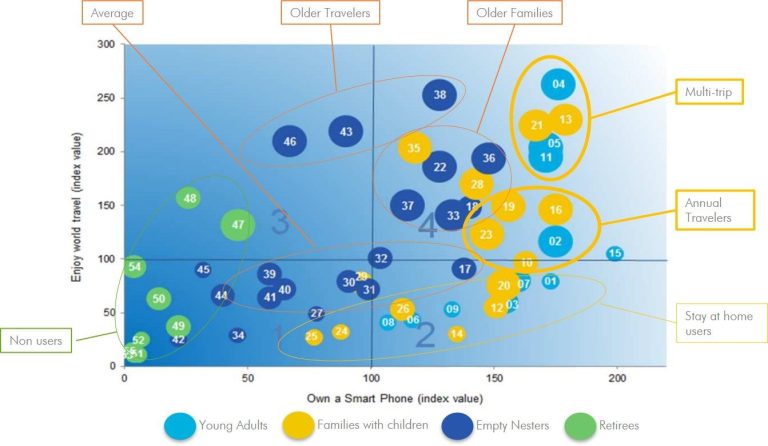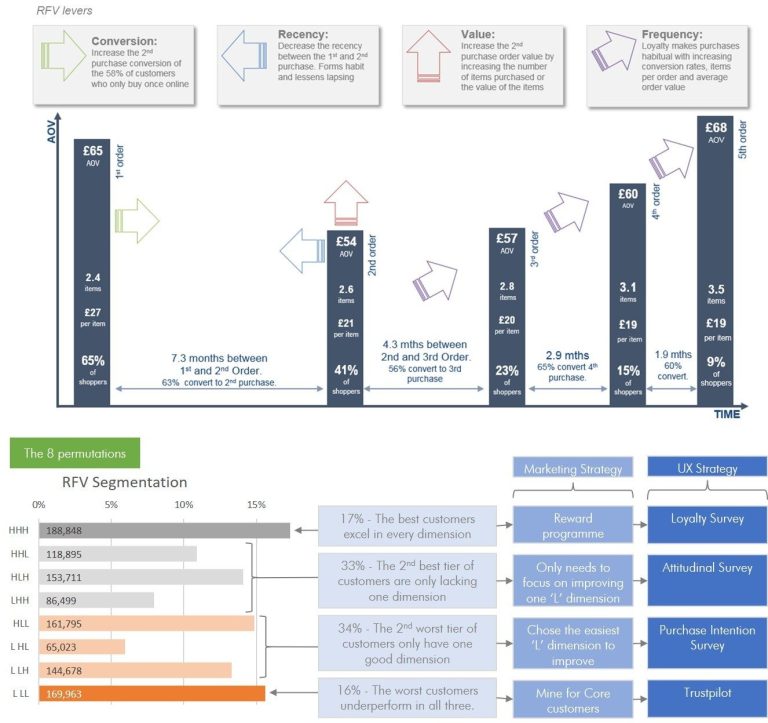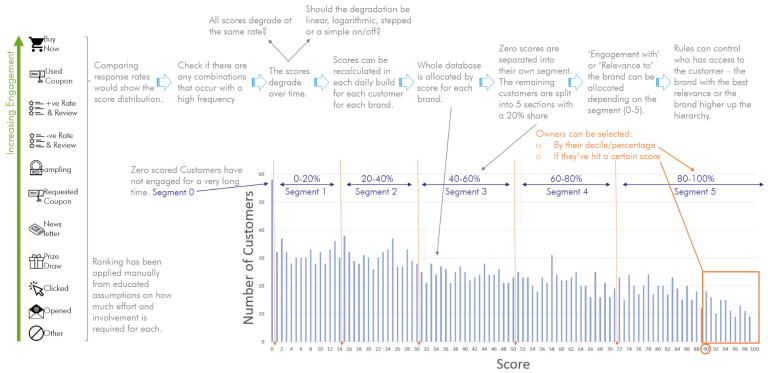Who
The ‘Who’ dimension creates the first difference between finance and marketing, enabling multi-dimensional choices. Great marketing must be relevant and connect on the human level, where they are in their busy lives. There are different ways of describing customers:
o Personas: a pen portrait of a typical customers which usually cannot be used to select from databases or paid marketing.
o Profiles: mathematical micro-clusters or rolled up clusters created by segmentation, grouping similar prospects/customers by key attributes. Can can be directly used for direct/digital marketing.
o Selections: specific groups of profiles cut by time/product/keyword used in specific campaigns.

Personas
[Stand]
Helps internal teams to understand that there are differences in the customer base and that ‘one size’ is unlikely to fit all customers.
Useful for general descriptions, creating propositions and briefing the marketing narrative and creative. Compares the differences and similarities of key characteristics, creating abstract ‘pen portraits’ that summarise distinct customer groups. Can be derived from market research, different types of segmentation tools, e.g. geodemographic or attitudinal, or just made up. Can be a bit vague and far too often cannot work with activation platforms directly, needing translation that weakens the targeting across platforms, removing many options use actual science to improved digital/direct marketing campaigns.

Segmentation
[Run]
Uses maths like Gaussian or K-Means to cluster everyone into salient groups, creating customer-led and very defined micro-cluster as the base constituent parts. Rolling these up into larger clusters or profiles (goldilocks sized - not too big, not to small) that make sense to the business.
Profiles enable tailored, focused marketing strategies designed to specifically appeal to their unique or shared characteristics. Profiles can also be rolled up to closely align with top level personas. Underpins and connets with all aspects of data/math in activation selections and understanding the ‘who’ in direct/digital marketing.

Traction
[Run]
Similar to penetration, which looks at depth of product (what) penetration into core markets and remaining headroom. Traction looks at how different tactics create that penetration over shorter time periods (gaining traction) for different profile (who) types. Multi-dimensional traction grids can investigate if they are responding to macro (seasonality, weather, economy, geo-demographics) v micro (price, need, marketing, channels).

Activation: RFV (Loyalty)
[Stand]
Recency, Frequency, Value. One of the simplest segmentations for business with reasonable repurchase expectations. Always a great starting point as based off transactional data, which is usually available and mostly complete. The trick is finding the best split into High/Low for 8 segments, or High/Mid/Low for 27 segments. RFV can be quickly translated into a marketing strategy and initial user experience (UX) tactics that can be tested – a quick learning opportunity whilst more evolved marketing science is being prepared.

Activation: Rs (Lapsing)
[Stand]
Every marketing plan has 2 ends and at the other end of the (positive) RFV view is the (negative) Rs view - an RFV for the non-loyal. Customers are expensive to recruit so worth understanding if spending more on a relevancy tactic, or deliberately scrubbing (excluding) them from selections to save money - which will directly increase ROI but will lose a tiny amount of tail-end sales.
Rather than looking at why they bought, looks at why they are not. Finesse the proposition for that last role of the dice. That said, it is worth ensuring everyone who can be legally contacted or targeted should get at least one comms per year, usually with the most attractive offer of the year, rather than spamming them because that’s how the plan was set up years ago.

Activation: Audiences
[Walk]
Another term about how actual customers or prospects are defined. But nomenclature is important as data is complex enough without creating confusion. Audiences are the actual selection criteria of a campaign. These can be built up by ‘including’ certain profiles within specific time-parameters, product ownership, etc, and ‘excluding’ profiles for reasons like legal opt-outs, recently purchased, been targeted too recently or set aside in a test/control group. There will usually need to be a priority/dedup cascade if many different selections are within the same campaign.
Selections are best controlled by prescriptive models, e.g. NPP model that will select the best targets, defined by score or volume. The selection can be provided complete for Retargeting in Owned/Paid channels or partial Lookalike audience for Paid acquisition channels.

Activation: Next Product
[Run]
Prescriptive Next Product Propensity (NPP) models really find their legs when used for selecting ‘Who’ as they are scored at the individual (or household) level. They can quickly pick up new inputs/signals and be often recalculated to produce ‘always-on’ targeting. They can be used in a few different ways, as well as helping to size potential markets and assist scenario analysis:
o What is the Next Product that they are most likely to buy when in the market next. Could also then suggest the 2nd and 3rd product to suggest a sequence of hero product offering. Next Product could actually be next category or price-point.
o The NPP priority can be used to prevent different marketing department being uncoordinated by and spamming/stalking the same people with disparate campaigns or messages at the same time - which will certainly increase costs and may diminish sales, customer satisfaction and ultimately reduce the contactable customer base by increasing opt-outs.
o NPP can also create the most powerful seed audiences for Lookalike Paid campaigns by picking the highest-most scoring customers to find similar prospects.


Employees
[Walk]
CRM and Marketing Science techniques are informing the building and use of ERPs. Employee data, especially if front-line staff data, can give a good insight to different behaviours and outcomes that could be encouraged, adapted or removed. Pareto suggests that 80% of issues comes from 20% of the people. Much of this could be addressed by changing systems or improving training around certain friction points. It could also identify the types of people who meld with the company the best (recruitment), creating value for money and spotting good alignments between certain types clients/needs and teams/employees.
An application of these techniques where first used in call-centre dialer models, that prescribed when best to carry out training (downtime) and on what - and was proven to positively affect customer staff retention.
We need your consent to load the translations
We use a third-party service to translate the website content that may collect data about your activity. Please review the details in the privacy policy and accept the service to view the translations.

